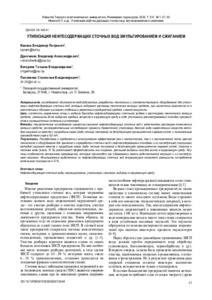Please use this identifier to cite or link to this item:
https://elib.psu.by/handle/123456789/24414| Title: | Утилизация нефтесодержащих сточных вод эмульгированием и сжиганием |
| Authors: | Иванов, В. П. Дронченко, В. А. Вигерина, Т. В. Пилипенко, С. В. Ivanov, V. Dronchenko, V. Vigerina, T. Pilipenko, S. |
| Other Titles: | DISPOSAL OF OIL-CONTAINING WASTEWATER BY EMULSIFICATION AND BURNING |
| Issue Date: | 2020 |
| Publisher: | Томский политехнический университет |
| Citation: | Disposal of oil-containing wastewater by emulsification and burning/ Ivanov Vladimir P., Dronchenko Vladimir A., Vigerina Tatiana V., Pilipenko Stanislav V. // Bulletin of the Tomsk Polytechnic University. Geo Аssets Engineering. 2020. V. 331. №1. 27–33 (ISSN 2413-1830) DOI https://doi.org/10.18799/24131830/2020/1/2444 |
| Abstract: | The relevance of the work is caused by the need to develop technology andappropriate equipment for disposal of oily wastewater that contain solutions of technical detergents, with the exception of their accumulation in significant volumes in the conditions of individual repair enterprises of medium and low power. The aim of the work isto eliminate contamination of soil and water basin with oily wastewater with solutions of technical detergents, reduce the share of emissions of harmful substances into the environment during the disposal of the considered waste in industrial boilers. Methods: theoretical studies of burning oily wastewater, with the inclusion of solutions of technical detergents; experimental studiesof thermal processing of this type of pollutants by burning them with natural gas (or furnace fuel) on an operatingindustrial steam boiler, with a nominal steam production of 6,5 t/h. Results. The authors have developed and proposed to use theefficient (from an environmental and economic point of view) technology and equipment for storing and treating waste water with oily waste and its subsequent utilization, by burning together with natural gas (or furnace fuel), in the existing industrial steam boiler. The presence of water in the fuel (about 10 %) increases the efficiency of its combustion, while reducing emissions of nitrogen oxides into the environment. The authors studied the features of the transformation mechanisms that occur during formation of water-fuel emulsion droplets and their subsequent combustion. The use of the energy source separated from the oil-containing waste water allows reducing the consumption of boiler fuel by 3–5 %. = Актуальность исследования обусловлена необходимостью разработки технологии и соответствующего оборудования для утилизации нефтесодержащих сточных вод, которые содержат растворы технических моющих средств, при исключении накопления их в значительных объемах в условиях отдельных ремонтных предприятий средней и малой мощности. Цель: исключить загрязнение почвы и водного бассейна нефтесодержащими сточными водами с растворами технических моющих средств, уменьшить долю выбросов вредных веществ в окружающую среду в ходе утилизации рассматриваемых отходов производства в промышленных котельных установках. Методы: теоретические исследования процессов сжигания нефтесодержащих сточных вод с включениями растворов технических моющих средств; экспериментальные исследования процесса термической утилизации данного вида загрязняющих веществ методом сжигания их вместе с природным газом (либо печным топливом) на действующем промышленной паровом котле, с номинальным производством пара в 6,5 т/ч. Результаты. Разработана и предложена к использованию эффективная (как с экологической, так и с экономической точки зрения) технология и оборудование для хранения и переработки сточных вод с нефтесодержащими отходами и их последующей утилизации методом сжигания вместе с природным газом (либо печным топливом) в действующем промышленном паровом котле. Наличие в топливе воды (около 10 %) увеличивает эффективность его сгорания, уменьшая выбросы оксидов азота в окружающую среду. Изучены особенности механизмов превращений, которые происходят при образовании капель водотопливной эмульсии и их последующем сжигании. Использование выделенного из нефтесодержащих сточных вод энергоресурса позволяет уменьшить потребление котельного топлива на 3–5 % |
| Keywords: | Oily wastewater Emulsification Utilization Incineration Emission to the environment Нефтесодержащие сточные воды Эмульгирование Утилизация Сжигание Выбросы в окружающую среду |
| URI: | https://elib.psu.by/handle/123456789/24414 |
| metadata.dc.identifier.doi: | 10.18799/24131830/2020/1/2444 |
| Appears in Collections: | Публикации в Scopus и Web of Science Технологическая подготовка и организация ремонтного производства |
Files in This Item:
| File | Description | Size | Format | |
|---|---|---|---|---|
| Ivanov_DISPOSAL_OF_OIL-CONTAINING.pdf | 1.09 MB | Adobe PDF |  View/Open |
Items in DSpace are protected by copyright, with all rights reserved, unless otherwise indicated.